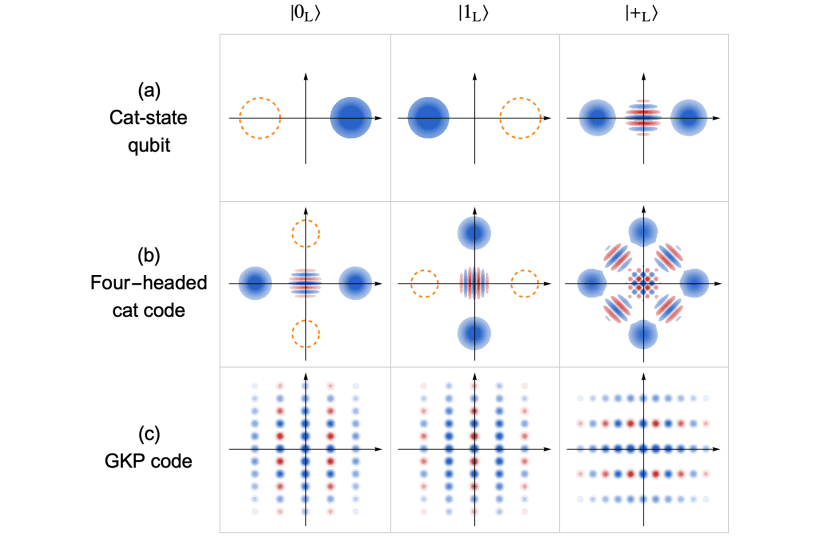Photons represent a promising medium for quantum information processing, offering speed and resilience to environmental noise without demanding extreme cooling, yet their weak interactions pose a significant hurdle to building practical quantum computers. Jaehak Lee from KIST and Korea University of Science and Technology, alongside Srikrishna Omkar and Yong Siah Teo from Seoul National University, and colleagues including Seok-Hyung Lee and Hyukjoon Kwon, address this challenge by exploring hybrid quantum computing. Their work surveys a novel approach that combines the strengths of different quantum encoding methods, effectively overcoming the limitations of weak photon interactions. This research clarifies how hybrid architectures enable more scalable and compatible quantum computers, explicitly outlining the resource requirements and error thresholds needed for fault-tolerant operation and highlighting the potential for efficient state generation and streamlined quantum operations.
Photonic Entanglement, Hybrid Quantum Systems, Teleportation
A vibrant field of quantum information processing is rapidly evolving, focused on building practical quantum computers. Researchers are increasingly exploring photonic systems, continuous variable quantum computing, and robust quantum error correction techniques, with a particular emphasis on combining the strengths of different quantum approaches. This work explores hybrid qubit encoding, combining discrete and continuous variables to create more resilient qubits. Quantum error correction remains a major focus, with significant progress in Gottesman-Kitaev-Preskill (GKP) codes, which encode qubits in continuous variables, and sparse-graph codes, autonomous quantum error correction systems requiring minimal external control. The integration of different qubit types, such as superconducting and photonic qubits, is gaining momentum, aiming to leverage the advantages of each. Continuous variable quantum computing, utilizing the infinite degrees of freedom of light, is also a prominent area of research, frequently appearing as a key application within hybrid entanglement schemes.
Cat-State Qubits Enable Deterministic Bell-State Measurement
Scientists are pioneering hybrid quantum computing approaches that combine discrete and continuous variable quantum systems, addressing a key limitation of scalable quantum technologies: weak photon interactions. This research focuses on engineering logical qubits from entangled combinations of single photons and coherent states, offering a synergistic pathway toward more robust and efficient quantum computation. This method offers advantages over traditional approaches, such as Gottesman-Kitaev-Preskill (GKP) states and binomial codes. Researchers have developed techniques to create cat-state qubits, superpositions of two coherent states, which enable nearly deterministic Bell-state measurements (BSMs) using a simple optical setup.
While these cat states are vulnerable to photon loss, scientists are overcoming these limitations by constructing hybrid qubits that combine the benefits of both discrete and continuous variables. The team employs dual-rail encoding for discrete-variable qubits, where logical states correspond to a single photon occupying one of two orthogonal modes, leveraging measurement-induced nonlinearities and teleportation to implement entangling gates. Scientists are enhancing the success probability of BSMs, crucial for scalability, by employing squeezing operations, ancillary entangled photons, or multi-photon encoding, achieving success rates exceeding 75% and even approaching 100% with advanced techniques. Furthermore, the integration of measurement-based quantum computing (MBQC) allows computation solely through single-qubit measurements on large entangled cluster states, offering a powerful paradigm for scalable quantum computation.
High Loss Tolerance in Hybrid Quantum Schemes
Scientists have achieved significant breakthroughs in hybrid quantum computation, demonstrating substantial improvements in loss thresholds and resource requirements for fault-tolerant quantum computing. Their work focuses on combining discrete and continuous variable quantum encoding to overcome limitations associated with weak interactions, a key obstacle to scalable quantum technologies. Researchers meticulously evaluated several hybrid schemes, including hybrid-qubit-based quantum computation (HQQC), hybrid-qubit-based topological quantum computation (HTQC), post-selected HTQC (PHTQC-n), and hybrid-cat-code quantum computation (HCQC). Detailed analysis reveals that PHTQC-2 and PHTQC-3 deliver the highest loss thresholds, exceeding 1%, while maintaining relatively small optimal encoding amplitudes.
These results demonstrate a relaxed requirement for precise state preparation, a significant advantage for practical implementation. HTQC achieved a substantial reduction in resource requirements, decreasing them by approximately four orders of magnitude compared to HQQC, while maintaining a loss threshold. Furthermore, the researchers explored the use of bosonic error correction codes with HCQC, employing a four-headed cat code, which allows for near-deterministic Bell state discrimination even with single photon loss, enhancing noise resilience and enabling efficient error correction.
Hybrid Photonic Quantum Computing Advantages Demonstrated
This review clarifies the potential of hybrid photonic quantum computing as a pathway towards scalable and practical quantum technologies. Researchers have demonstrated that combining discrete and continuous variable photonic encodings offers significant advantages in mitigating the challenge of weak photon-photon interactions, a key obstacle in many quantum systems. This work details how this hybrid approach enables more efficient generation of essential resource states and allows for nearly ballistic operations, simplifying the complexity of quantum gate control. By explicitly presenting error thresholds and resource overheads, the team facilitates a clear comparison between different quantum computing architectures and highlights the benefits of the hybrid method for achieving fault-tolerant quantum computation. While acknowledging that single-photon-based quantum computing faces challenges related to loss, this work demonstrates how the hybrid approach offers a promising route to overcome these limitations.

